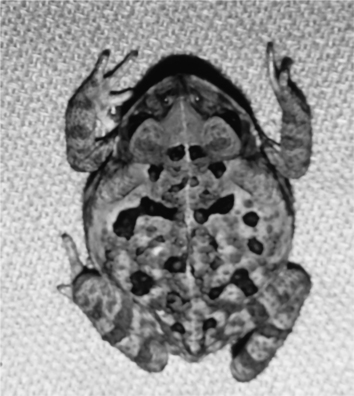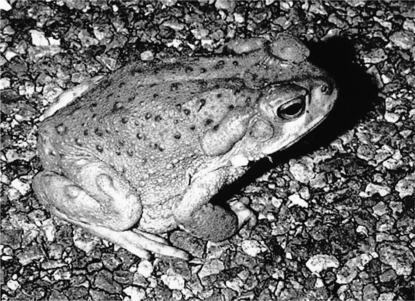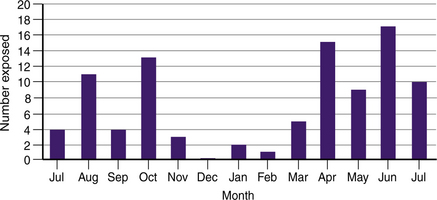Chapter 81 Toads
SOURCES
There are more than 200 species of Bufo toads in the world. These toads have been used for centuries in religious rituals, witchcraft, and healing. Even today toad excretions are used by South American and Mesoamerican tribes as fertility enhancers. In the United States the Food and Drug Administration listed one of the toad excretions, bufotenine, as a Schedule 1 substance in 1967 because of “toad licking” and “toad smoking” by drug addicts.1
The two most common Bufo species that cause poisonings in small animals in the United States are the cane or marine toad (Bufo marinus) (Figure 81-1) and the Colorado River toad (also known as the Sonoran desert toad) (Bufo alvarius) (Figure 81-2).2 The European Bufo vulgaris and the Asian Bufo gargarizans are related species that can cause poisonings. Colorado, Arizona, Texas, Hawaii, and Florida are the principal locations in the United States where small animals are exposed to toads and suffer from poisonings. Bufo toads were introduced into the southern states from Hawaii for insect and rodent control.3 The foreign toads have replaced many native species because of their hardiness and proliferative reproductive capabilities.
Exposures usually occur during the summer months in the Southeast and during periods of high humidity or late summer in the Southwest.2 Bufo toad exposures have been reported throughout the year in Florida (Figure 81-3) except in the month of December.4 Toads are most active after a period of rainfall, especially at dawn, dusk, and evening hours. All Bufo species have parotid glands on their dorsum that release toxic substances when the toad is attacked or threatened. These toxins are biologically active compounds.1
TOXIC DOSE
Toxicity truly varies and is size dependent and dose dependent. Larger toads have larger parotid glands and therefore have more voluminous excretions. The most severe clinical signs of toxicosis are seen in animals with low body weight that have encountered a large toad for a prolonged period of time.4 Although most small animals do not consume Bufo toads, severe toxicosis occurs in animals that masticate or hold the toads instead of just biting and then releasing the toad. Exposure to 1 mg/kg of secretions is required for the induction of clinical signs of intoxication.5
TOXICOKINETICS
Toxins secreted from the parotid glands of Bufo toads are rapidly absorbed across the mucous membranes and then enter the systemic circulation.3 The toxins can also be absorbed through the gastric mucosa following ingestion, through open skin wounds, and across the conjunctiva. Once the toxins have entered the systemic circulation, the greatest effects are seen on the heart, peripheral vasculature, and nervous system.1 Bufo toads release many substances that are naturally found in the body, such as the catecholamines, epinephrine, norepinephrine, dopamine, and serotonin; the metabolism of these biologically active compounds occurs in a manner similar to normal physiology. Examples include catecholamine reuptake and metabolism by monoamine oxidase and catechol O-methyltransferase.6 Elimination of bufagenins, which are the digitalis-like substances, occurs via first-order kinetics, and these substances are excreted through the urine.6
MECHANISM OF TOXICITY
The biologically active substances produced by Bufo toads include the following: dopamine, epinephrine, norepinephrine, serotonin, bufotenine, bufagenins, bufotoxins, and indolealkylamines.1,3 All Bufo species produce these substances, but there is variation in the quantity of each substance produced by different toads. For instance Bufo marinus and Bufo viridis contain the highest known plasma level of endogenous digitalis-like substances, which are collectively known as bufadienolides.7 Indolealkylamines have been characterized as similar to the hallucinogen, lysergic acid diethylamide (LSD).2
Bufotenine, or 5-hydroxydimethyltryptamine, has been definitively identified as a pressor, but there is also evidence that this compound may be a hallucinogen or have a “psychedelic” effect.1,8 The hallucinogenic effects of bufotenine may be secondary to the known systemic pressor activity and oxygen starvation of the optic nerve.1 Only the Colorado River toad (Bufo alvarius) releases 5-MeO-DMT (5-methoxydimethyltryptamine) from the methylation of serotonin; it acts as a true hallucinogen.9
Bufagenins and bufotoxins are cardioactive steroids also known as digitalis-like substances.7 The bufagenins act like digitalis to inhibit potassium-dependent adenosine triphosphatase, which is the enzyme that allows active transport of sodium out of and potassium into cells.7 Digitalis-like substances can cause alterations in heart rate and rhythm. Any type of arrhythmia can result from digitalis overdose, especially bradycardia and supraventricular and ventricular tachycardias. Bufotoxins are vasoconstrictors and add to the pressor effect of bufotenine to increase systemic vascular resistance.1
Although many of the substances released from Bufo toads are known to cause vasoconstriction and an increase in blood pressure, there has been no documentation to support this pressor activity.3
Stay updated, free articles. Join our Telegram channel

Full access? Get Clinical Tree





